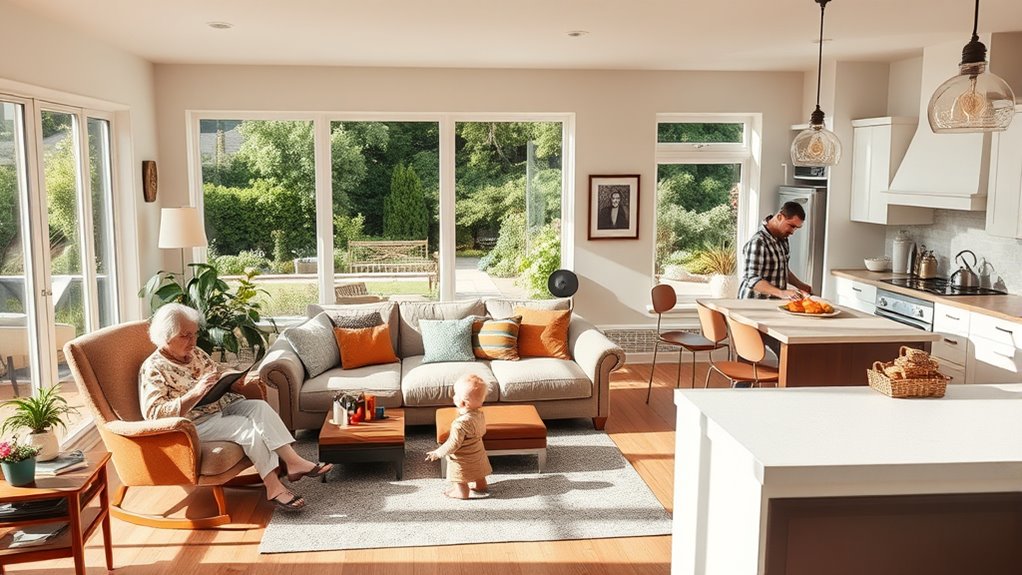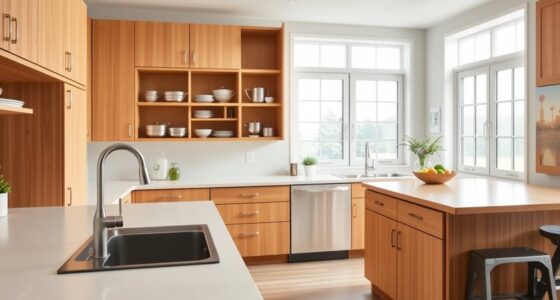To create a successful multi-generational living space, plan for private areas with separate entrances and adaptable layouts to meet evolving needs. Incorporate accessibility features like wider doorways and ramps, and design shared spaces for responsibilities like cooking and chores. Balance privacy with communal bonds by respecting boundaries and fostering open communication. Understand local regulations and community norms to guarantee smooth approval. Keep exploring for expert tips on tailoring your home to fit your family’s unique dynamics.
Key Takeaways
- Design separate entrances and private units to ensure independence and privacy for each generation.
- Incorporate adaptable layouts with multi-use rooms and future accessibility features like ramps or elevators.
- Plan shared common areas responsibly, assigning chores and management roles to prevent conflicts.
- Use durable, weather-resistant materials and universal design elements to enhance safety and longevity.
- Understand local zoning laws and obtain necessary permits to ensure legal compliance and community support.
Understanding the Cultural Foundations of Multi-Generational Living
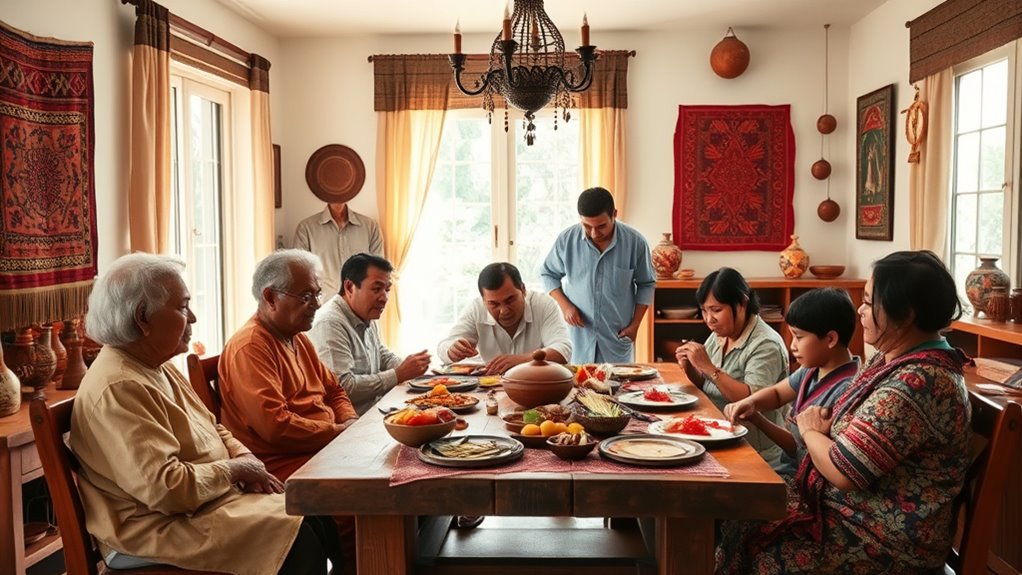
Have you ever wondered why multigenerational living remains so prevalent in cultures like Bangladesh? It’s deeply rooted in cultural traditions that value family cohesion and uphold a strong family hierarchy.
In these households, elders are respected and cared for, often within the home itself, reflecting a moral obligation rather than formal systems of elder care. Family members, especially sons, stay with their parents, while daughters may live with in-laws, maintaining traditional roles and responsibilities. This practice often aligns with American Diner Classics, which emphasize hearty, shared meals that bring families together across generations.
Shared household chores, finances, and caregiving strengthen bonds and create a support system that’s both practical and culturally meaningful. This practice keeps cultural values alive across generations, emphasizing the importance of community, respect, and the continuity of family ties. Additionally, cultural practices such as multigenerational living are often reinforced by long-standing traditions that prioritize family unity.
Designing a Home That Supports Privacy and Accessibility
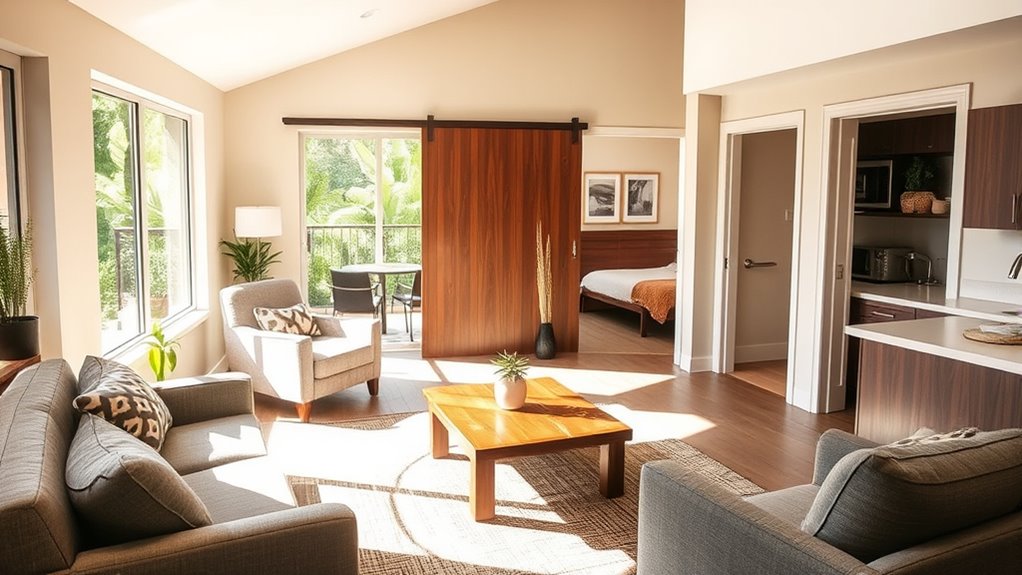
Creating a multi-generational home that balances privacy and accessibility requires thoughtful design choices. You should include private bedrooms with individual entrances and en-suite bathrooms to guarantee personal space for each generation. Incorporating durable materials in construction can enhance the longevity and weather resistance of the home, reducing maintenance costs over time. Designing separate entry points or access routes helps maintain independence and minimizes disruptions. Incorporate universal design features such as wider doorways, ramps, and non-slip flooring to promote accessibility for residents with mobility challenges. Use zoning strategies like HVAC zones and soundproofing to create comfortable, quiet environments tailored to individual needs. Additionally, include adaptable spaces such as guest suites or flexible rooms that can be easily modified for accessibility upgrades or changing family requirements. Considering cost and budgeting factors during planning can help ensure your multi-generational home remains financially sustainable and aligns with your overall goals. Paying attention to building codes and regulations can further ensure your home meets safety standards and legal requirements. Exploring innovative construction techniques can also contribute to creating more adaptable and efficient living environments. Thoughtful planning assures everyone’s privacy, comfort, and independence in your multi-generational home.
Creating Separate Entrances and Independent Living Areas
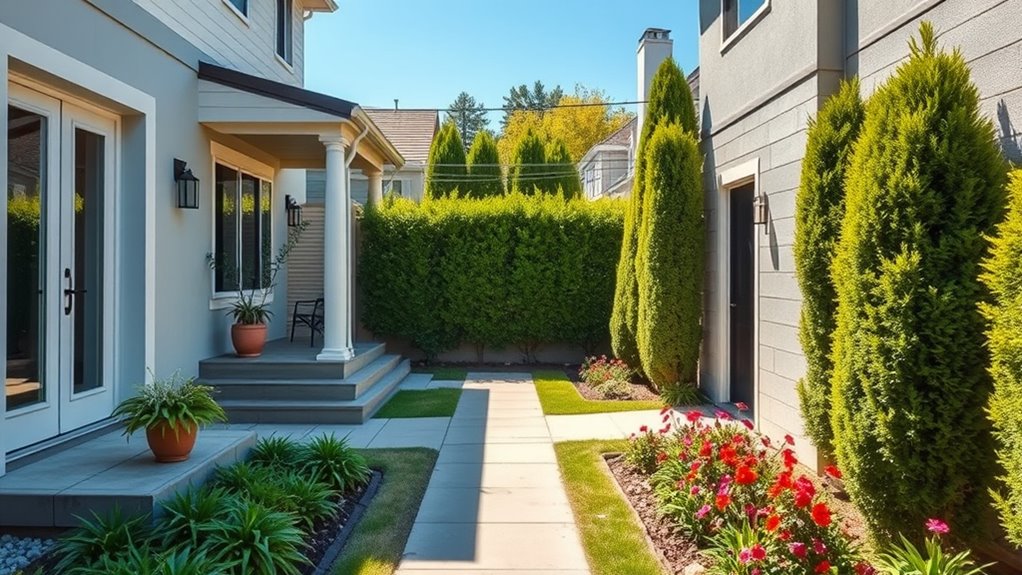
How can you guarantee each household in a multigenerational home maintains its privacy and independence? By incorporating separate entrances and independent living areas into your home design. This allows residents to come and go freely, minimizing disruptions and preserving personal space. Separate entrances can be front or side doors with individual pathways, clearly defining each household’s domain. Providing private access supports autonomy for elderly or disabled family members, making mobility easier. Understanding size restrictions for tiny houses is essential when planning to ensure each unit complies with local regulations and fits within the property. Additionally, integrating remote work setups in each unit can facilitate professional independence and flexibility for working family members. Homes with distinct living suites or apartments increase flexibility and privacy for everyone. Plus, independent access boosts security and convenience, letting family members or guests enter without passing through shared spaces. Incorporating self watering plant pots in outdoor areas can help maintain lush, low-maintenance gardens that enhance the sense of a private sanctuary for each household. Considering multi-unit housing options can also optimize space and provide additional privacy features for multigenerational living, especially when designed with soundproofing techniques to reduce noise transfer.
Managing Shared Spaces and Household Responsibilities
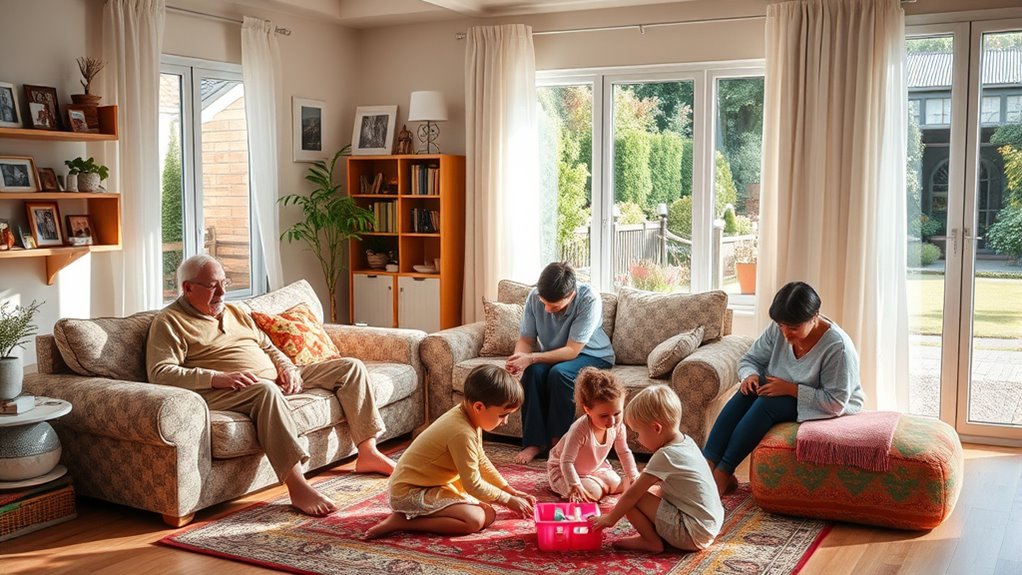
Once separate entrances and independent living areas are in place, establishing clear household responsibilities becomes essential to guarantee smooth daily life. Shared spaces like kitchens, laundry rooms, and living areas require organization and respect. Assigning chores, managing expenses, and caregiving duties prevent misunderstandings and foster harmony. Respecting personal boundaries, such as closed doors and private bedrooms, helps preserve privacy and reduces conflicts. Regular communication and check-ins keep everyone informed and allow issues to be addressed promptly. Implementing designated zones within the home, like soundproofed bedrooms or separate entrances, minimizes disturbances. Use this table to clarify roles and shared responsibilities:
| Shared Space | Household Responsibilities | Privacy Measures |
|---|---|---|
| Kitchen | Cooking, cleaning | Private storage, scheduled use |
| Laundry | Washing, folding | Quiet hours, designated machines |
| Living Room | Shared use, cleaning | Respect personal space |
Additionally, understanding home technology can facilitate better communication and automation of household tasks. Being aware of privacy policies and user consent options can also support a respectful and secure living environment. Incorporating security measures such as cameras or smart locks can further enhance safety and peace of mind for all household members. Practicing mindful decluttering can also help maintain an organized space that supports harmony and reduces stress within shared environments.
Balancing Emotional Wellbeing and Family Dynamics
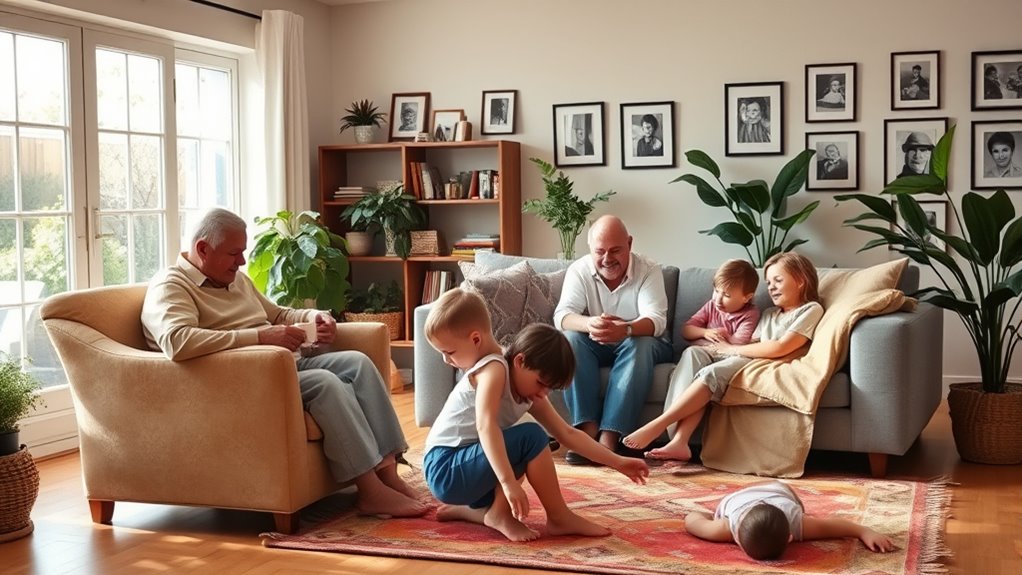
To keep emotional wellbeing strong in a multigenerational home, you need to foster open communication about expectations and boundaries. Respecting personal space and privacy helps reduce stress and prevents conflicts. When everyone’s emotional needs are acknowledged and respected, family dynamics become more harmonious. Incorporating human-centered roles like counseling and social work can also support maintaining healthy relationships within the household. Utilizing Pimple Patches can serve as a metaphor for addressing small issues early, preventing larger conflicts from developing.
Fostering Open Communication
Fostering open communication is essential for balancing emotional wellbeing and family dynamics in a multigenerational household. When everyone feels heard, misunderstandings and resentment lessen, promoting household harmony.
Regular family meetings create a space to share feelings, expectations, and concerns openly. Clear communication about boundaries and responsibilities helps each person understand their role, reducing friction. Understanding store hours can also help in planning errands and managing schedules more effectively, contributing to household stability. Additionally, recognizing home organization principles can improve overall household functioning and reduce stress. Incorporating family routines can further strengthen bonds and create a predictable environment for all generations. Emphasizing the importance of symbolism in dreams can also foster deeper understanding and connection among family members, especially when discussing shared experiences or cultural traditions.
Practicing empathy and active listening shows respect and strengthens emotional bonds. Addressing issues kindly and promptly keeps conflicts manageable and fosters a supportive environment. Staying informed about regulatory frameworks that can impact household financial decisions and safety is also beneficial for long-term stability.
Respecting Personal Boundaries
Respecting personal boundaries is essential for maintaining emotional wellbeing and smooth family dynamics in a multigenerational household. You can do this by designating private spaces, like bedrooms, personal bathrooms, and quiet areas, to help family members feel secure and respected.
Establish household rules, such as knocking before entering closed doors, to prevent boundary violations and foster mutual respect.
Recognize and honor differing routines, habits, and parenting styles to reduce conflicts and create harmony.
Open communication about individual needs and boundaries builds trust and minimizes misunderstandings.
Incorporating physical boundary markers, like separate entrances or zoning, allows independence within shared spaces.
Being aware of vape juice expiration and proper storage can prevent health issues and ensure safety for all household members who might use such products. Additionally, educating family members about privacy and safety promotes a respectful environment and reduces potential conflicts. Understanding the importance of electric bike horsepower can also encourage family members to pursue healthier, eco-friendly transportation options.
Incorporating Flexible Layouts for Evolving Needs
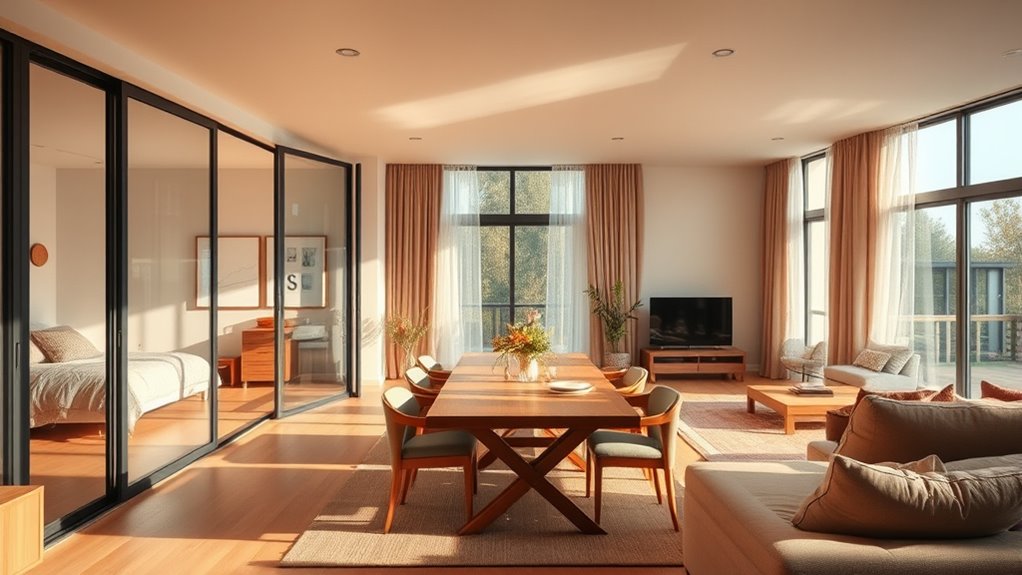
Incorporating flexible layouts into your home design allows spaces to adapt seamlessly to changing family needs over time. You can use moveable partitions or sliding doors to expand or contract rooms as required, providing quick adaptability.
Convertible rooms, like transforming a guest bedroom into a home office or senior suite, enhance versatility and meet evolving needs.
Designing multi-use common areas, such as combined living and dining spaces, maximizes space efficiency while supporting various activities.
Planning for future modifications, like adding an elevator or universal design features, ensures accessibility without major renovations later.
Zoning the home with separate entrances, bathrooms, and private retreats helps family members maintain independence.
These strategies foster adaptability, making your home resilient to future changes.
Navigating Regulations and Community Acceptance
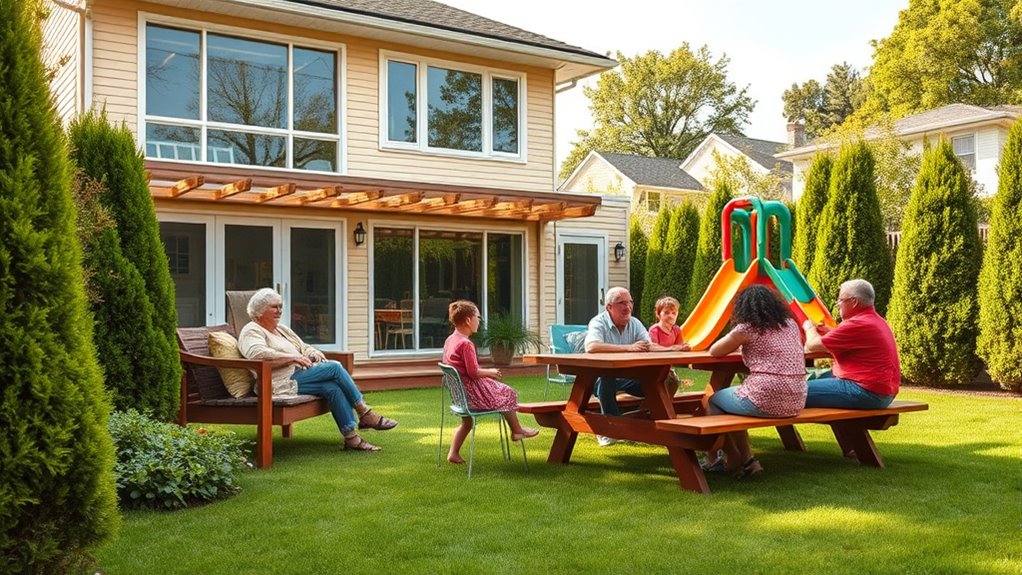
Before you start building, it’s important to understand local regulations and obtain the necessary permits, as rules vary widely by area.
Engaging with community members and local officials can help gain support and reduce resistance to your project.
Local Regulations and Permits
Managing local regulations and permits is a crucial step in creating a successful multigenerational living space. You need to understand how building permits, zoning laws, and accessory dwelling units (ADUs) apply to your property. Non-compliance can lead to fines or legal issues, so early engagement with local authorities is essential.
Consider these points:
- Research your municipality’s zoning laws related to ADUs and home modifications
- Obtain necessary building permits for adding entrances, bathrooms, or elevators
- Clarify restrictions on multi-family or shared living arrangements
- Confirm your plans align with local regulations before starting construction
- Maintain thorough documentation to demonstrate compliance during inspections
Staying informed and proactive helps you navigate regulations smoothly, avoiding setbacks and ensuring your project meets community standards.
Building Community Support
Building community support is essential for the success of your multigenerational housing project, as gaining acceptance often depends on strong relationships with local officials and neighbors. Engaging with local government committees and neighborhood associations helps foster understanding and support. Many municipalities have strict regulations for ADUs and multigenerational units, so knowing zoning laws, building codes, and approval processes is vital. Participating in public hearings and advocating for policy reforms can ease regulatory hurdles and promote community acceptance. Developing relationships with local leaders influences zoning policies that accommodate multigenerational living. Sharing successful examples and educating residents can shift perceptions and build broader support. Remember, strong community backing often hinges on transparent communication and active involvement.
| Engagement Method | Key Benefit | Example |
|---|---|---|
| Public Hearings | Facilitates policy reform | Advocating for zoning changes |
| Neighborhood Meetings | Builds trust and understanding | Sharing project benefits |
| Local Government Outreach | Eases regulatory hurdles | Meeting with officials |
| Community Education | Shifts perceptions | Showcasing successful homes |
| Partnering with Leaders | Influences regulations | Collaborating with community groups |
Tips for Maintaining Harmony and Strengthening Bonds
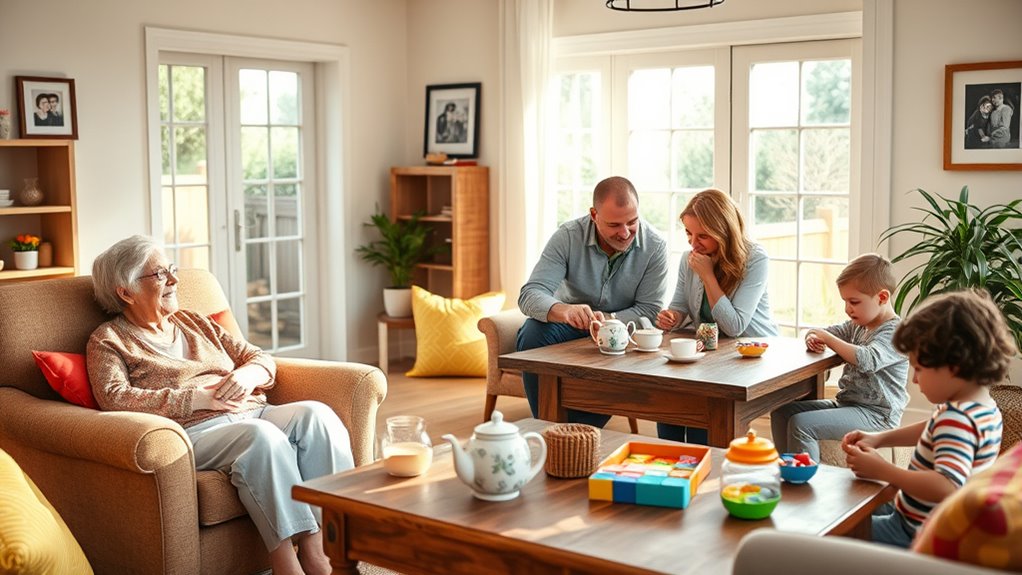
Maintaining harmony in a multi-generational living space requires intentional effort and clear communication. You need to foster open dialogue to address concerns before they escalate.
Respect personal space by creating designated private areas and encouraging knocking before entering shared rooms. Clearly define responsibilities for chores, expenses, and caregiving to promote fairness and reduce conflicts.
Engage in shared activities like cooking, gardening, or movie nights to strengthen emotional bonds and build a sense of community.
Practice patience, flexibility, and understanding, knowing that adjusting to multi-generational living takes time. By prioritizing these practices, you can nurture harmony and deepen bonds within your household.
- Establish open communication channels for honest conversations
- Respect personal boundaries with designated private spaces
- Share chores and responsibilities fairly
- Participate in shared activities regularly
- Practice patience and adaptability
Frequently Asked Questions
How to Create a Multi-Generational Home?
To create a multi-generational home, you need to plan for separate bedrooms, bathrooms, and private entrances to guarantee everyone’s privacy.
Incorporate accessible features like ramps and elevators for mobility needs.
Use zoning strategies such as soundproofing and designated communal areas to balance shared spaces with privacy.
Add outdoor zones for each generation’s preferences.
Design flexible rooms that can adapt to future needs, all while following local regulations.
What Does the Bible Say About Multi-Generational Living?
The Bible values multi-generational living, emphasizing respect and care for elders. You’re encouraged to honor your parents and support your family, as Proverbs 17:6 highlights the joy of having grandchildren.
By living together, you promote unity, passing down faith and traditions.
Scripture like Joshua 24:15 and 1 Timothy 5:8 remind you that caring for family across generations is a moral responsibility rooted in love and community.
What Are the Disadvantages of a Multigenerational Household?
They say, “Too many cooks spoil the broth,” and that’s true for multigenerational households. You might face conflicts over privacy, boundaries, and household chores.
Scheduling can become a headache, and differences in parenting or cultural expectations may cause misunderstandings.
Plus, resources could stretch thin, increasing costs. The lack of personal space can even impact mental health.
While living together has benefits, these challenges can make harmony difficult to achieve.
What Is It Called When Multiple Families Live on the Same Property?
When multiple families live on the same property, it’s often called a multi-family household or multigenerational living arrangement. You might also hear it called household sharing, especially when separate living spaces exist for each family.
In real estate, these setups are known as duplexes, triplexes, or multifamily dwellings, depending on the number of units. This arrangement fosters community but can also bring about unique challenges.
Conclusion
Creating a multi-generational home is like weaving a rich tapestry of family bonds and individual needs. By thoughtfully balancing privacy, shared spaces, and emotional wellbeing, you build more than just a house—you craft a sanctuary where generations grow together in harmony. Embrace flexibility and open communication as your guiding stars, and watch your home become a resilient, warm haven that nurtures love and connection for years to come.
